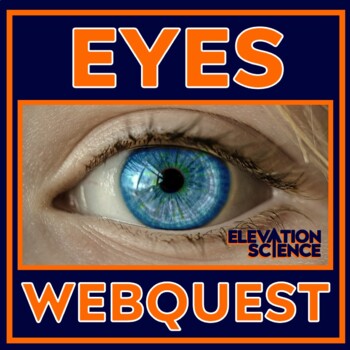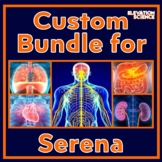Human Body Systems Eye Webquest Anatomy How the Eye Works Activity
Elevation Science
638 Followers
Elevation Science
638 Followers

Includes Google Apps™
The Teacher-Author indicated this resource includes assets from Google Workspace (e.g. docs, slides, etc.).
Also included in
- This is a custom bundle for Serena.Please consider clicking HERE to follow Elevation Science on TPT!Price $33.60Original Price $48.00Save $14.40
Description
GOOGLE DOCS AND PRINT VERSION INCLUDED! Use this eye activity for self-guided internet-based learning about eye part functions, cone and rod cells, eye health, and vision in other animals. Includes fun optical illusion activity!
In this anatomy activity, students will…
- Learn the main parts of the eye and how they function
- Have fun with an optical illusion
- Learn about eye health and common vision problems
- Compare human eyesight to that of some other types of animals
Teacher Notes:
- Please note that this resource is not editable.
- Answer key included.
- A link to the Google Docs version is included in the downloadable PDF.
- You may also be interested in our Human Body Systems Webquest Bundle!
Please consider clicking HERE to follow Elevation Science on TPT!
Total Pages
4 pages
Answer Key
Included
Teaching Duration
N/A
Report this resource to TPT
Reported resources will be reviewed by our team. Report this resource to let us know if this resource violates TPT’s content guidelines.
Standards
to see state-specific standards (only available in the US).
CCSSRST.6-8.4
Determine the meaning of symbols, key terms, and other domain-specific words and phrases as they are used in a specific scientific or technical context relevant to grades 6–8 texts and topics.
CCSSRST.6-8.7
Integrate quantitative or technical information expressed in words in a text with a version of that information expressed visually (e.g., in a flowchart, diagram, model, graph, or table).
NGSSMS-LS1-2
Develop and use a model to describe the function of a cell as a whole and ways the parts of cells contribute to the function. Emphasis is on the cell functioning as a whole system and the primary role of identified parts of the cell, specifically the nucleus, chloroplasts, mitochondria, cell membrane, and cell wall. Assessment of organelle structure/function relationships is limited to the cell wall and cell membrane. Assessment of the function of the other organelles is limited to their relationship to the whole cell. Assessment does not include the biochemical function of cells or cell parts.
NGSSMS-LS1-3
Use argument supported by evidence for how the body is a system of interacting subsystems composed of groups of cells. Emphasis is on the conceptual understanding that cells form tissues and tissues form organs specialized for particular body functions. Examples could include the interaction of subsystems within a system and the normal functioning of those systems. Assessment does not include the mechanism of one body system independent of others. Assessment is limited to the circulatory, excretory, digestive, respiratory, muscular, and nervous systems.
NGSSMS-PS4-2
Develop and use a model to describe that waves are reflected, absorbed, or transmitted through various materials. Emphasis is on both light and mechanical waves. Examples of models could include drawings, simulations, and written descriptions. Assessment is limited to qualitative applications pertaining to light and mechanical waves.






